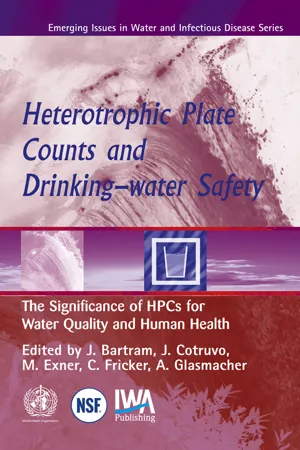
Heterotrophic Plate Counts and Drinking-water Safety
- 150 pages
- English
- PDF
- Available on iOS & Android
Heterotrophic Plate Counts and Drinking-water Safety
About This Book
Heterotrophic Plate Counts and Drinking-water Safetyprovides a critical assessment of the role of the Heterotrophic Plate Count (HPC) measurement in drinking water quality management. It was developed from an Expert workshop of 32 scientists convened by the World Health Organization and the WHO/NSF International Collaborating Centre for Drinking Water Safety and Treatment in Geneva, Switzerland. Heterotrophs are organisms, including bacteria, yeasts and moulds, that require an external source of organic carbon for growth. The HPC test (or Standard Plate Count), applied in many variants, is the internationally accepted test for measuring the hetrotrophic microorganism population in drinking water, and also other media. It measures only a fraction of the microorganisms actually present and does not distinguish between pathogens and non-pathogens. High levels of microbial growth can affect the taste and odor of drinking water and may indicate the presence of nutrients and biofilms which could harbor pathogens, as well as the possibility that some event has interfered with the normal production of the drinking water. HPC counts also routinely increase in water that has been treated by an in-line device such as a carbon filter or softener, in water-dispensing devices and in bottled waters and indeed in all water that has suitable nutrients, does not have a residual disinfectant, and is kept under sufficient conditions. There is debate among health professionals as to the need, utility or quantitative basis for health-based standards or guidelines relating to HPC-measured regrowth in drinking water. The issues that were addressed in this work include: the relationship between HPC in drinking water (including that derived from in-line treatment systems, dispensers and bottled water) and health risks for the general public the role of HPC as an indirect indicator or index for pathogens of concern in drinking water the role of HPC in assessing the efficacy and proper functioning of water treatment and supply processes the relationship between HPC and the aesthetic acceptability of drinking water. Heterotrophic Plate Counts and Drinking-water Safetyprovides valuable information on the utility and the limitations of HPC data in the management and operation of piped water systems as well as other means of providing drinking water to the public. It is of particular value to piped public water suppliers and bottled water suppliers, manufacturers and users of water treatment and transmission equipment and inline treatment devices, water engineers, sanitary and clinical microbiologists, and national and local public health officials and regulators of drinking water quality.
Frequently asked questions
Information
Table of contents
- Cover
- Contents
- Foreword
- Acknowledgements
- List of acronyms and abbreviations
- Robert Koch
- 1: Expert consensus
- 2: Public health aspects of the role of HPC — an introduction
- 3: The history and use of HPC in drinking-water quality management
- 4: The presence of bacteria in water after regrowth
- 5: Bacteria of potential health concern
- 6: Relationships between common water bacteria and pathogens in drinking-water
- 7: Epidemiological and riskassessment evidence of diseaselinked to HPC bacteria
- 8: Infections from HPC organisms in drinking-water amongst the immunocompromised
- 9: Methods to identify and enumerate frank and opportunistic bacterial pathogens in water and biofilms
- 10: Conditions favouring coliform and HPC bacterial growth in drinkingwater and on water contact surfaces
- 11: Managing regrowth in drinkingwater distribution systems
- 12: The role of HPC in managing the treatment and distribution of drinking-water
- Index